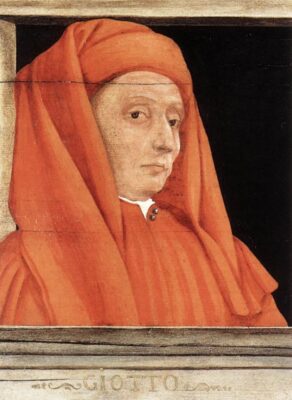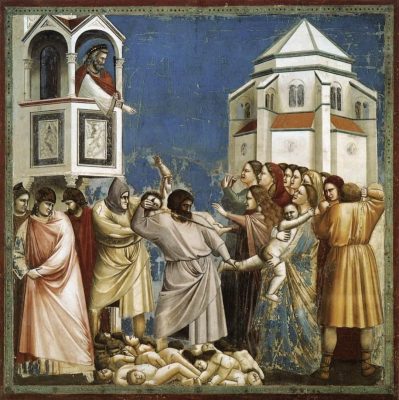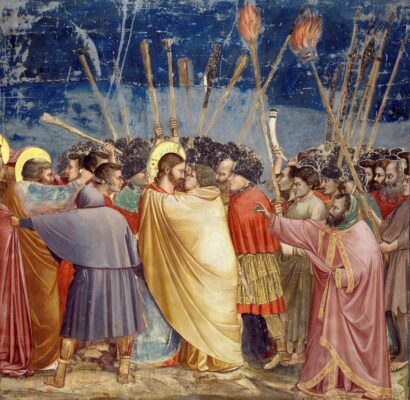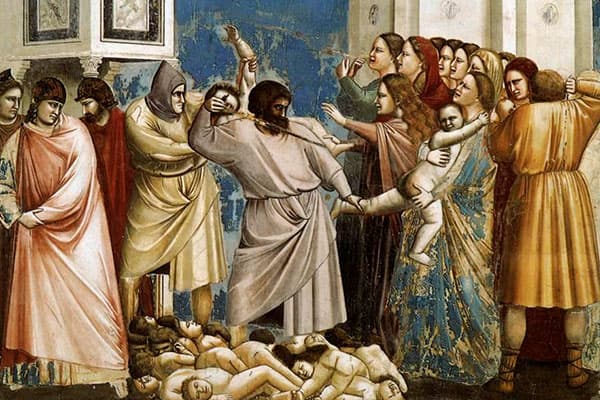Giotto di Bondone
«Credette Cimabue nella pittura / Tener lo campo, ed ora ha Giotto il grido/ sì, che la fama di colui oscura»
Dante, La Divina Comedia
En su «La Vida de los artistas», Giorgio Vasari escribió que cierto día, el pintor florentino Cimabue (c.1240-1302) iba caminando por el campo cuando observó sorprendido a un joven pastor, apenas un niño, que pintaba con tiza blanca e inusual soltura unas ovejas sobre una roca. Al preguntar el maestro por su nombre, el crío respondió: «me llamo Giotto, y mi padre se llama Bondone«.
Imagen: Paolo Uccello: presunto retrato de Giotto di Bondone
Sea cierta o no esta anécdota, lo cierto es que nos sirve para realizar una primera aproximación a Giotto di Bondone (1266-1337), el pintor que, con sus dotes inusualmente imaginativas, sus novedosas iconografías, y su destacable amor por la naturaleza y la expresión humana, revolucionó el Arte occidental hasta el punto de que se le considera, no sin razón, el primer nombre de la pintura europea, ensalzado por sus contemporáneos Dante, Tetrarca y Boccaccio. En este sentido, Giotto «personifica el nuevo gusto dantesco, con todo lo que esta palabra significa de interés por los sentimientos humanos» (Historia del Arte, Salvat Editores, Tomo 5, 1981). A su muerte, acaecida en 1337, a la edad de 70 años, dejó una escuela con discípulos de categoría (Bernardo Daddi, Taddeo Gaddi, etc.) que encauzaron la pintura florentina hasta la llegada de los grandes maestros cuatrocentistas.
Las primeras obras de Giotto, aún muy cercanas a Cimabue, ya comienzan a mostrar abiertamente algunas de sus características pictóricas originales: es el caso del Crucifijo de la Iglesia de Santa Maria Novella, en Florencia (entre 1290-1295), donde la humanización de la figura de Cristo se aleja brutalmente de los crucifijos bizantinos.
Giotto di Bondone: frescos en la Capilla Scrovegni: «La Masacre de los Inocentes» y «El Beso de Judas». 1304-05
La primera obra maestra de Giotto son los frescos que realiza en la Iglesia superior de la Basílica de San Francisco en Asís, entre 1296 y 1300, basados en La leyenda de San Buenaventura. Sin embargo, estas obras no alcanzan la perfección de los frescos realizados para la Capilla Scrovegni , en Padua, donde, además de la calidad individual de cada escena (desde el dramatismo de la «Matanza de los Inocentes» hasta los misteriosos rostros de las mujeres en «El encuentro de San Joaquín y Santa Ana«) se añade el valor de la concepción espacial del conjunto de la Capilla. Giotto pinta otra nueva serie de frescos para la Iglesia de la Santa Croce , ya en su madurez (c. 1325)
Además de los frescos, Giotto realizó varias pinturas sobre tabla, destacando la «Madonna en majestad» (conocida como la «Madonna Ognissanti«) en el que el rostro de la Virgen , lejos de la frialdad e inexpresividad hierática de las madonnas bizantinas, muestra una expresividad que sugiere la posibilidad de que haya sido tomado de una modelo de la época. También se sabe que Giotto destacó en el campo de la Arquitectura, recibiendo el encargo del campanile de la Catedral de Florencia, aunque probablemente no llegó a realizar más que los bocetos.
En definitiva, Giotto es a la pintura occidental un fenómeno al cual todos intentaron seguir pero nadie consiguió alcanzar, ni mucho menos superar, hasta la aparición de Fra Angelico y los primitivos flamencos de comienzos del siglo XV.
G. Fernández · theartwolf.com
Contenido relacionado
Follow us on:




